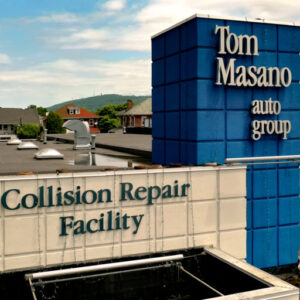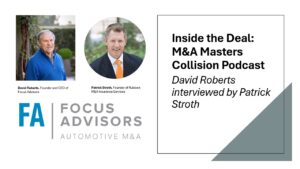June 20, 2025 –
The other day, we were talking to the owner of a collision repair business who said “in the body shop business, I made a living. But I never made a fortune because I never bought my building.”
As the collision repair industry’s leading mergers and acquisitions advisors, our team here at Focus Advisors has talked to hundreds of collision repair entrepreneurs, and one thing that has stood out to us over the years is how owning one’s real estate can create significant wealth when it comes time for an exit.
For existing or aspiring collision repair owners, we see three primary ways owning their real estate can help create and maintain the value of their collision enterprise:
1. Increasing value upon an exit. If the business owner is looking to sell their enterprise, they will become the landlord for the buyer of the business. When the transaction closes, the buyer will sell a long-term, triple-net (NNN) lease with the landlord, with rent determined as a share of the business’s trailing twelve months of gross sales.
2. Diversification upon an exit. Many entrepreneurs in the collision repair industry have the lion’s share of their net worth tied up in their business and the underlying real estate. By selling their business, but holding onto the building, they are able to diversify their risk so that the total value of their business and their property are no longer tied to their success alone.
3. Helping finance growth. For high-performing single-shops or multi-shop operators (MSOs) looking to accelerate their growth, they can borrow against their real estate equity to finance acquisitions. Alternatively, one could borrow against their property to buy “build-to-suit” brownfield or greenfield development sites.
Later in this article, we’ll dive into each of these three value-drivers in more detail.
Real Estate and Consolidation in Collision Repair
It’s widely known that the United States collision repair industry is consolidating at a rapid pace. Larger MSOs are acquiring or building shops. And the largest operators, the consolidators, are backed by private equity (PE) capital and now account for a third of the industry’s market share.
These large private equity-backed consolidators don’t own their real estate. The reason for that is they don’t want to tie up their expensive capital in long-term assets that create wealth slowly.
Most of the largest consolidators in the collision industry, such as Crash Champions, Caliber, Classic Collision, etc., are financed by private equity. Their sponsor PE firms deploy their capital out of funds that have specific mandates to invest in a certain asset class.
Typically, a PE fund with a mandate to invest in operating companies doesn’t also have a mandate to invest in real estate. If they did want to own real estate, they would set up a different fund that would specifically focus on that.
The main reason for keeping the strategies separate is because real estate has a fundamentally different risk and return profile than does a collision enterprise. PE funds investing in collision repair operations have return-on-investment expectations that far exceed historical returns for real estate. That’s in part because there is much greater risk involved in profiting from an acquired business than there is for buying property and land that will never lose all of its value.
Real estate is also an asset class that takes time to generate value. On the other hand, PE funds tend to have a specified, limited-life time horizon, such as 10 years. Therefore, they want to generate value out of acquiring and growing collision repair businesses and then realize those returns at the end of their fund life.
In short, PE firms don’t want to muddle the strategies and dilute the returns.
Sometimes, in order to get a deal done, consolidators will buy the seller’s real estate all in one transaction, but they will not hold onto it for very long. This happens if the seller would like to have a complete exit rather than lease out their property to the buyer. But immediately after closing on both the business and the real estate, the consolidator re-draws the lease to make it more favorable to their long-term objective and then they promptly sell it to an institutional buyer of real estate, often a real estate investment trust (REIT).
We have observed that selling both the real estate and the business to the same buyer all in one transaction surrenders a great degree of value.
Value Driver 1: Real estate increases value upon an exit.
When collision repair owners explore an exit with a buyer, and decide to hold on to the real estate, they will enter into a long-term lease with the buyer. This lease is typically triple-net (NNN) and amounts to 5% or 6% of the seller’s last twelve months of sales, unless local fair market values are significantly different. The lease should include certain rent escalators that take effect every few years. Most leases are 10 years with a few extension options.
That’s one of the aspects that makes collision repair unique. When valuing one’s property, many owners will often use LoopNet or CoStar or a real estate broker to provide them with local rents or comparable property values. In so doing, they’ll see “10,000 square foot industrial properties in this part of town get X amount in rent.”
But that’s not how to value collision repair-occupied real estate. The lease tends not to be based on market-rate rents per square foot, but instead, they are based on existing sales. For operators generating a high volume of sales out of a small footprint shop, come exit-time, they will be able to secure an above-market rent because of those high sales.
However, the primary value driver here is what’s called “cap rate compression”.
Commercial real estate is valued based on two things: net operating income and capitalization rates.
The net operating income (NOI) for a property is the revenues generated by the property less the operating costs of running the property. The operating costs are typically maintenance, utilities, insurance, and property taxes. In a NNN lease structure, the tenant pays for these operating costs separately from the rent they pay the landlord. So that NNN rent that most often amounts to 5% or 6% of sales is approximately the NOI for the building.
So the NOI is the income stream for the property. The second component of valuing the property is how highly investors value that income stream. The metric of how much they value that income stream is the capitalization rate (“cap rate”). A cap rate estimates the potential rate of return on an investment property. Less risky properties have lower capitalization rates, since investors don’t need to be compensated for as much risk.
So NOI divided by the cap rate is the value of a property. However, different tenants have different risk profiles. A large private equity-backed consolidator is viewed as a “credit tenant”. This means that they have a large balance sheet that attracts institutional investors to invest in properties occupied by them.
This difference in risk profile for the credit tenant consolidators versus small, local businesses is the real lever of value. By way of example, let’s say a collision repair entrepreneur has the choice of selling their business and leasing their property to a nearby single-shop operator versus a consolidator. And let’s say that their business is doing $5 Million in annual sales. Assuming a 5% rent factor, their NNN rent would be $250,000 per year.
Option 1: Sell to a local single shop
Value of property = $250,000 NOI / 11.5% cap rate = $2.17 Million
Option 2: Sell to a large consolidator
Value of property = $250,000 NOI / 6.5% cap rate = $3.85 Million
The example shows that a credit-worthy tenant – for the same amount of rent – might create 77% more value for the property. That is solely the effect of cap rate compression.
In summary, the less risky the tenant from an investor’s perspective, the lower the cap rate, and the higher the value for the real estate.
For this reason, we advise collision repair owners to focus first on selling the business to the right buyer, then – only once it’s sold and the lease is signed – to explore selling the property.
Keep in mind that owning one’s real estate might enhance the value of the business itself. That’s because risks involved in acquiring a business with a third-party landlord can erode the confidence of potential buyers – or worse – make a deal go sideways. The body shop deal graveyard has many tombstones due to disinterested landlords trying to take advantage of a transaction to improve their situations. How, might you ask? Lease assignments that require the landlord’s consent.
Operators can’t eliminate all of the risks that real estate presents. As M&A advisors, we’ve seen our fair share of difficult or unreachable landlords, challenging local land use policies or fire marshals, environmental risks at a property, or informal arrangements or easements with neighbors.
When one owns their business and its facility, and the time comes to sell it or to hand it down to the next generation, there is much less risk of a third party getting in the way of a transaction, or surprises coming up with the property. Owner-occupiers looking to sell will have more control over the transaction and have more flexibility in structuring the deal. This can enhance the total value of the enterprise, property value aside.
Value Driver 2: Real estate provides diversification upon an exit.
Most collision repair entrepreneurs have created the bulk of their net worth through their businesses and their real estate. While that can be a high figure, it’s not diversified.
Investors know that diversifying their portfolio of assets helps enhance returns and mitigates risk.
One of the benefits of real estate ownership is that it allows collision repair entrepreneurs to view selling their business as a diversification strategy. They can sell their business, invest those proceeds elsewhere, and hold onto the property. By signing a long-term NNN lease with a buyer, they get to receive what we call “mailbox money”, benefit from property value enhancement through that cap rate compression and still have some investment exposure to the collision repair industry by virtue of their tenants.
For example, just a few years ago, Classic Collision was a nascent collision repair consolidator. The folks who sold their businesses to them in those early days were making a bet on Classic and that they’d be able to perform well in this industry. As time went on, Classic acquired more shops and sold to a very large PE company, and now they’re one of the five largest consolidators in the country. As such, real estate investors now view them as a creditworthy tenant because Classic Collision has a large balance sheet. As Classic grew in size and reputation, the market’s perception of risk for the buildings leased by Classic declined, so that the owners who sold to them many years ago now have much more valuable properties. This story isn’t unique to Classic Collision – many of the super-regionals and consolidators have helped their landlords experience significant equity appreciation.
So, by selling one’s business to the right buyer and leasing the property to them, a seller’s net worth is neither as concentrated nor as dependent on their success alone.
Folks who sell their businesses have ample choices for how they decide to invest the proceeds of the sale. But they can also benefit from borrowing against their increased equity in the building, given its enhanced value. A property with lots of equity built up is a piggy bank with which to further diversify one’s investments.
Value Driver 3: Real estate helps finance growth
The first two value drivers that we outlined assumed collision repair owners who are ready and prepared for an exit. If instead, they’re looking to grow their enterprise, real estate is a mechanism for that. They could borrow against their property or divest some of the ownership of the property to outside investors in order to free up investment capital.
Real estate ownership provides many tax advantages, too. For instance, many owners that we talk to, particularly those with C-Corps, like to pay themselves above-market rent through the business, therefore reducing their business’s EBITDA and corporate taxes, but enhancing the value of the property.
However, if an entrepreneur’s aim is to expand into a larger MSO in a short timeframe without involving outside capital, we’d encourage them to think like a PE-backed consolidator. You’ll recall from earlier in this piece we said that PE capital is expensive. Well, an entrepreneur’s should be, too. Let’s examine some numbers:
Buy a $4 Million revenue shop for $2 Million.
Put $1 Million down and get a $1 Million note from the seller.
The business generates $300K in cash flow after debt service; that’s a 30% cash-on-cash return.
Alternatively, one could buy the real estate under that $4 Million shop for $2 Million.
Put $400K down and get a $1.6 Million note. This yields more like $65K in net cash flows (NNN rent less covering debt service); that’s a 16% cash-on-cash return.
One gets to choose: 30% or 16% returns. If they wants to grow quickly, they should buy the business, but not the property. And if one already owns their property has built up significant equity, they can borrow against that equity to buy shops to grow their MSO.
And if they’re looking to preserve their capital for business acquisitions, we can’t recommend enough that they are very thoughtful about the risks associated with whatever real estate they choose to lease in order to avoid any pitfalls that might come later. On the bright side, we’ve seen many collision repair entrepreneurs negotiate advantageous terms in their leases – including specific rent escalators and options to buy the property – and it has rewarded them greatly. But it requires due diligence and forethought.
Final note on growth and real estate: Being able to buy the real estate also gives operators more flexibility when pursuing brownfield and greenfield developments. Owning “the dirt” gives the operator more control over budgets, layouts and timing. Many small to mid-sized MSOs have grown through developments; while there’s no clearinghouse of data to consult, we’re confident that most of these operators acquired the dirt as part of the projects.
Parting Thoughts
Whether a collision repair entrepreneur owns their real estate or not, we hope that what we shared helps them re-consider how they evaluate real estate as an important aspect of their enterprise. This industry offers many pathways to create value for an entrepreneur. One pathway is to focus on growing into a large MSO through numerous acquisitions. Another way is to acquire the real estate with an eye towards total value-creation at an exit. When evaluating any growth strategy, real estate should be a part of that process, and one should consider its utility for borrowing, tax advantages, operational flexibility, diversification, cap rate compression, and so forth.
Every enterprise in this industry is unique. If you’re a collision repair entrepreneur and would like to talk more about your specific goals for growth and/or an exit, please reach out to our team for a confidential conversation.
About Focus Advisors
Focus Advisors (www.focusadvisors.com) is the leading M&A firm in the collision industry, a FINRA-registered and regulated investment bank, representing MSOs, dealerships, larger single shops, equipment distributors, and paint jobbers, helping entrepreneurs create and realize equity value by providing expert advice, raising capital, and facilitating the sale of their businesses. With 25 years of industry experience, Managing Director David Roberts, a co-founder of Caliber Collision, has led more than 46 transactions with a combined transaction value exceeding $600 million including Tripp’s Collision, Tom Masano Dealership Collision, and Colorado Auto Body.
Investment Banking Services and Securities offered through Independent Investment Bankers Corp., Member FINRA/SIPC. Focus Advisors is not affiliated with Independent Investment Bankers Corp.






